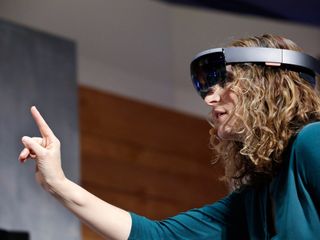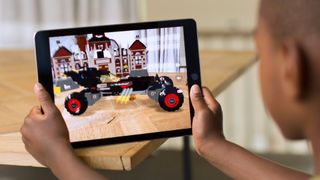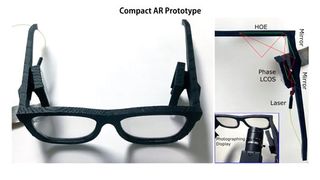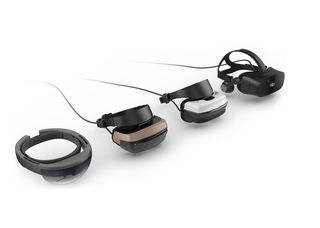Even without consumer-focused HoloLens, Microsoft must market AR sooner than later
Xbox head Phil Spencer recently stated that a consumer-ready augmented reality (AR) headset like Microsoft's HoloLens is at least five to 10 years away. If that's the case, what should Microsoft do in the meantime?

Spencer said:
"I think we're five to 10 years away from a true untethered device that's at a consumer price point that has the fidelity of experience and the kind of ease of use that you need to get to scale.
The good news is Microsoft seems committed to realizing its "holographic computing for everyone" vision. The bad news is that five to 10 years without a consumer-facing AR device in the market could be disastrous for Microsoft's mindshare among consumers.
Apple's ARKit for iOS 11 will bring augmented reality to hundreds of millions of iPhone and iPad users beginning this fall. Though crude, cumbersome and elementary by HoloLens standards, it is "AR" nonetheless.

I'm convinced Apple's strategy is meant to build developer support, an ecosystem of AR apps and consumer demand for an eventual AR headset or glasses. While Apple is dominating mainstream and tech news cycles with its evolving AR solution, Microsoft's more advanced HoloLens and industry-specific Windows Mixed Reality AR accomplishments may be relegated, as they are now, to the shadows.
Even without a consumer version of HoloLens, if Microsoft seizes the opportunity obscurity doesn't have to be its fate.
Making marketing a priority

According to an internal company memo from Corporate Vice President of Windows and Devices Yusuf Mehdi, Window Mixed Reality which powers both virtual reality (VR) and AR, will get a big marketing push later this year:
As we gear up for this coming holiday season, we enter a new phase of bringing mixed reality to everyone. To match the industry-defining technical work of our engineering team and to build on the broader work to establish the category of Mixed Reality, I am excited today to announce some changes within our team to enable us to accelerate our market presence.I am creating a dedicated Mixed Reality Marketing Team, separating it from the Surface devices team. With support from [Chief Marketing Officer] Chris [Caposella] and [CEO] Satya [Nadella], we created a CVP level role to head this effort. I am thrilled to announce ... we have found an ideal leader in Elizabeth Hamren, the former CMO of Oculus VR at Facebook.
Mehdi's creation of a dedicated marketing team for Windows Mixed Reality reflects the importance of AR and VR to Microsoft and its intent to be a major player in these markets. Also, since Windows Mixed Reality includes both VR and AR, a reasonable expectation is that the new marketing team will aggressively market both platforms, though Microsoft's AR investments are not yet consumer-focused.
Get the Windows Central Newsletter
All the latest news, reviews, and guides for Windows and Xbox diehards.
Marketing AR is a must
We know that the fully immersive VR experiences that Microsoft's partners will bring to market via mixed reality VR headsets will get a push this holiday season.

Without a consumer-focused AR product, however, how will Microsoft market AR experiences, where holograms are overlayed on the real world, as we see with HoloLens? This question is particularly relevant since Spencer stressed the consumer investments Microsoft is making in VR while downplaying HoloLens and emphasizing its "not-designed-for-consumers" status:
It [HoloLens] wasn't made for everybody, we've said that, it's a developer kit. Now we're doing kind of the other end with Windows Mixed Reality [VR] and $299 with OEM partners.
Where does this leave Hamren's focus as the corporate vice president responsible for marketing VR and AR? Can Microsoft market its AR platform without consumer-facing AR hardware? I think so.
Augmenting the AR conversation
News that HoloLens version two will be skipped to "accelerate version three" saw a mixed reception. Some believe any new product, while development continues, is better than no product at all. Others see the arrival of version three a year earlier, in 2019 rather than 2020, as being worth the sacrifice of version two.
The question is what will HoloLens version three be? In 2015, Nadella stated that a consumer version of the category-defining wearable computer was five years away. That would have been 2020. Will that consumer HoloLens be the version three we are now expecting in 2019?
Microsoft CEO Satya Nadella said in 2015 that HoloLens is a five-year journey.
Though Spencer's statements of an affordable, capable and scalable consumer AR headset being five to 10 years out were not an official statement of Microsoft's timeline, it raises two questions: Has development been slower than Nadella initially expected, pushing the delivery of a consumer version of HoloLens out by up to ten years? Or is Spencer's vision more advanced than what Nadella sees as a sufficiently capable and still valid consumer headset that could be available in 2019?
More streamlined in time

Spencer also said the following:
I think to get to real scale here, we're in that five- to 10-year horizon to get to untethered, things that happen that I don't feel like I have a helmet on. But we have to go through the transitions.
Spencer sees consumer AR wearables as not giving users the feeling they're wearing a helmet. Perhaps what Nadella envisions for an initial consumer HoloLens will be just as "geeky" as the VR headsets that Microsoft and its partners are pushing to consumers this year.

A less streamlined, "helmet-like" consumer HoloLens could simply be an iterative step on a roadmap toward what Spencer describes. It's inevitable, after all, that this technology will become more streamlined, batteries will become more efficient and processors and "displays" more powerful. With that in mind, if Microsoft can release suitable consumer versions of HoloLens which naturally improve over time, perhaps it should.
Microsoft must market its AR story
Whatever the 2019 version of HoloLens turns out to be and any versions that follow will be important. Equally as important is the messaging or the story Microsoft tells to give its AR efforts context.
Most consumers are being educated to believe that AR is limited to the two-dimensional overlay of digital artifacts on the real world, as viewed through the limited window of a mobile device. The popularity of Pokemon Go and the coming deluge of "AR" apps via iOS 11's ARkit are and will be responsible for this very limited understanding of AR's current and potential capabilities.

Hamren has the unique opportunity and responsibility to forge a message, a story, about Microsoft's AR endeavors that entices both consumers and the enterprise. She can lead the Mixed Reality Marketing Team to promote, through an engaging campaign, the encompassing environment of 3D holograms as viewed through the head-mounted HoloLens.
She can also emphasize the multisensory approach of Microsoft's AR investment that includes spatial sound. Combined with 3D objects, HoloLens also creates an ambient audio experience. Gesture, voice and gaze interaction are parts of the story, as well.
Even without a consumer version of HoloLens, Microsoft should run an aggressive television campaign that shows consumers and businesses what entities like NASA, the US Military, auto dealerships, the education sector, health care, entertainment, private developers and more are doing with it and Windows Mixed Reality.
Microsoft's AR story is ready to be told
HoloLens and AR are more than concepts. They're a reality with real-world, even life-saving, uses today as seen in the video below. Microsoft needs to tell its AR story. Now.
HoloLens is used to train doctors in life-saving procedures.
As consumers hear the story, it'll build excitement, awareness, mindshare and potential demand for how Microsoft is using the technology. It would also set a high bar for what consumers and enterprise will "understand" AR to be. If Microsoft begins such a campaign now, when Apple launches iOS 11 "AR" apps this fall, consumers will naturally compare Microsoft's far more advanced solution to Apple's offering.
In conjunction with this ongoing campaign, perhaps Microsoft should launch a consumer AR wearable as early as 2019. What do you think?
Jason L Ward is a columnist at Windows Central. He provides unique big picture analysis of the complex world of Microsoft. Jason takes the small clues and gives you an insightful big picture perspective through storytelling that you won't find *anywhere* else. Seriously, this dude thinks outside the box. Follow him on Twitter at @JLTechWord. He's doing the "write" thing!

